child lock SUZUKI XL7 2007 2.G Owners Manual
[x] Cancel search | Manufacturer: SUZUKI, Model Year: 2007, Model line: XL7, Model: SUZUKI XL7 2007 2.GPages: 274, PDF Size: 6.12 MB
Page 18 of 274
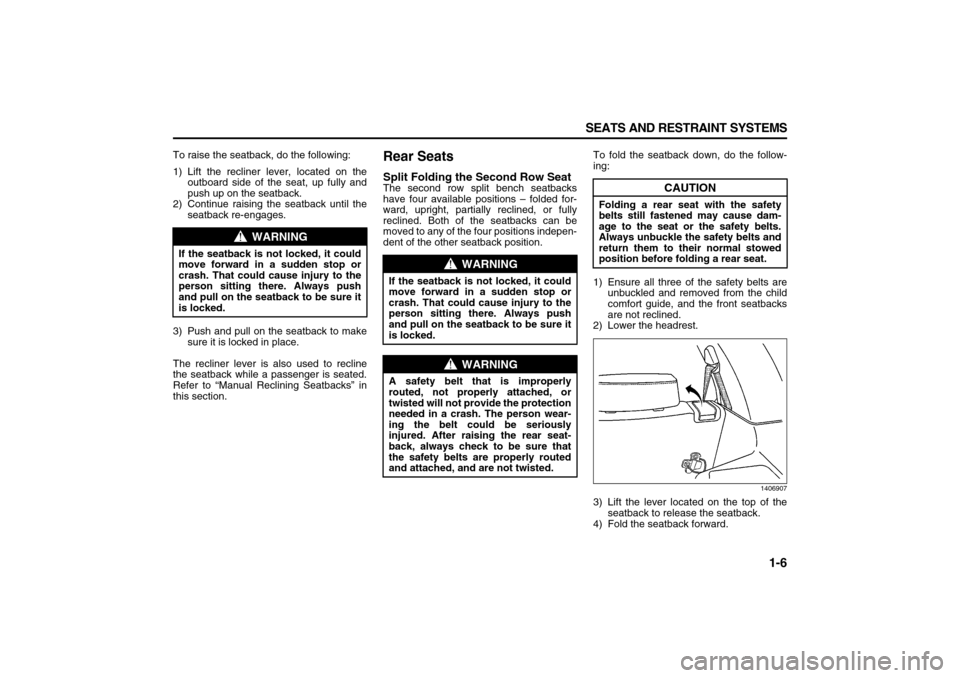
1-6 SEATS AND RESTRAINT SYSTEMS
78J00-03E
To raise the seatback, do the following:
1) Lift the recliner lever, located on the
outboard side of the seat, up fully and
push up on the seatback.
2) Continue raising the seatback until the
seatback re-engages.
3) Push and pull on the seatback to make
sure it is locked in place.
The recliner lever is also used to recline
the seatback while a passenger is seated.
Refer to “Manual Reclining Seatbacks” in
this section.
Rear SeatsSplit Folding the Second Row SeatThe second row split bench seatbacks
have four available positions – folded for-
ward, upright, partially reclined, or fully
reclined. Both of the seatbacks can be
moved to any of the four positions indepen-
dent of the other seatback position. To fold the seatback down, do the follow-
ing:
1) Ensure all three of the safety belts are
unbuckled and removed from the child
comfort guide, and the front seatbacks
are not reclined.
2) Lower the headrest.
1406907
3) Lift the lever located on the top of the
seatback to release the seatback.
4) Fold the seatback forward.
WARNING
If the seatback is not locked, it could
move forward in a sudden stop or
crash. That could cause injury to the
person sitting there. Always push
and pull on the seatback to be sure it
is locked.
WARNING
If the seatback is not locked, it could
move forward in a sudden stop or
crash. That could cause injury to the
person sitting there. Always push
and pull on the seatback to be sure it
is locked.
WARNING
A safety belt that is improperly
routed, not properly attached, or
twisted will not provide the protection
needed in a crash. The person wear-
ing the belt could be seriously
injured. After raising the rear seat-
back, always check to be sure that
the safety belts are properly routed
and attached, and are not twisted.
CAUTION
Folding a rear seat with the safety
belts still fastened may cause dam-
age to the seat or the safety belts.
Always unbuckle the safety belts and
return them to their normal stowed
position before folding a rear seat.
Page 23 of 274
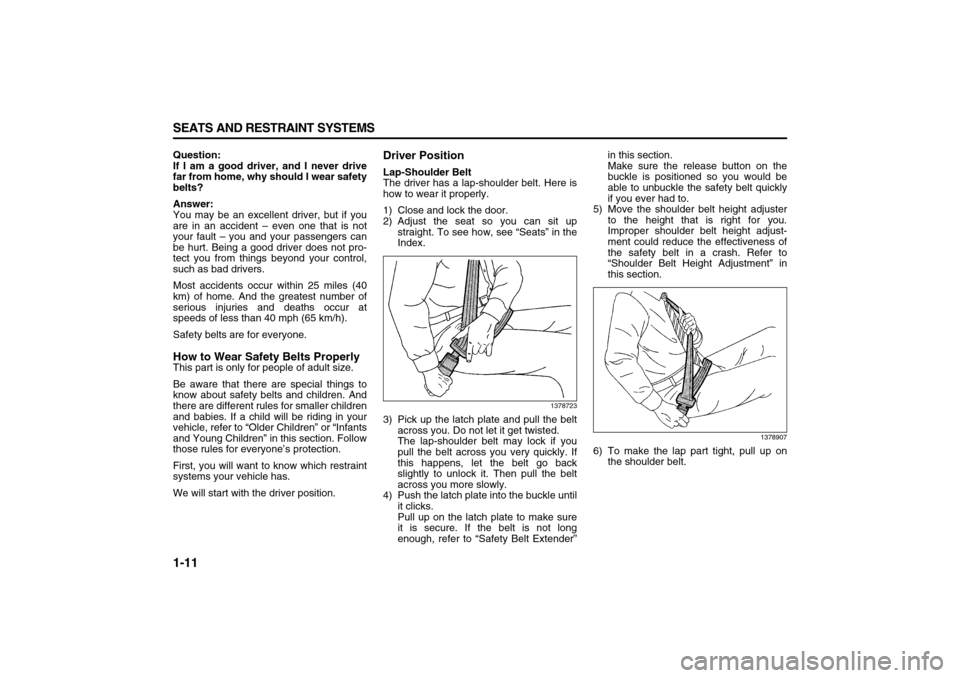
1-11 SEATS AND RESTRAINT SYSTEMS
78J00-03E
Question:
If I am a good driver, and I never drive
far from home, why should I wear safety
belts?
Answer:
You may be an excellent driver, but if you
are in an accident – even one that is not
your fault – you and your passengers can
be hurt. Being a good driver does not pro-
tect you from things beyond your control,
such as bad drivers.
Most accidents occur within 25 miles (40
km) of home. And the greatest number of
serious injuries and deaths occur at
speeds of less than 40 mph (65 km/h).
Safety belts are for everyone.How to Wear Safety Belts ProperlyThis part is only for people of adult size.
Be aware that there are special things to
know about safety belts and children. And
there are different rules for smaller children
and babies. If a child will be riding in your
vehicle, refer to “Older Children” or “Infants
and Young Children” in this section. Follow
those rules for everyone’s protection.
First, you will want to know which restraint
systems your vehicle has.
We will start with the driver position.
Driver PositionLap-Shoulder Belt
The driver has a lap-shoulder belt. Here is
how to wear it properly.
1) Close and lock the door.
2) Adjust the seat so you can sit up
straight. To see how, see “Seats” in the
Index.
1378723
3) Pick up the latch plate and pull the belt
across you. Do not let it get twisted.
The lap-shoulder belt may lock if you
pull the belt across you very quickly. If
this happens, let the belt go back
slightly to unlock it. Then pull the belt
across you more slowly.
4) Push the latch plate into the buckle until
it clicks.
Pull up on the latch plate to make sure
it is secure. If the belt is not long
enough, refer to “Safety Belt Extender”in this section.
Make sure the release button on the
buckle is positioned so you would be
able to unbuckle the safety belt quickly
if you ever had to.
5) Move the shoulder belt height adjuster
to the height that is right for you.
Improper shoulder belt height adjust-
ment could reduce the effectiveness of
the safety belt in a crash. Refer to
“Shoulder Belt Height Adjustment” in
this section.
1378907
6) To make the lap part tight, pull up on
the shoulder belt.
Page 27 of 274
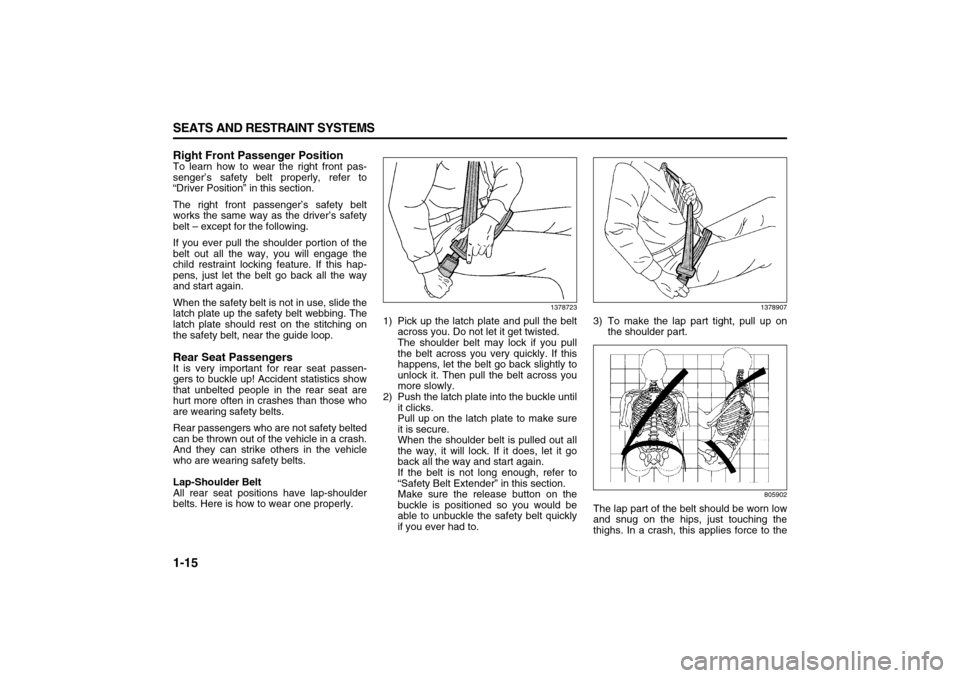
1-15 SEATS AND RESTRAINT SYSTEMS
78J00-03E
Right Front Passenger PositionTo learn how to wear the right front pas-
senger’s safety belt properly, refer to
“Driver Position” in this section.
The right front passenger’s safety belt
works the same way as the driver’s safety
belt – except for the following.
If you ever pull the shoulder portion of the
belt out all the way, you will engage the
child restraint locking feature. If this hap-
pens, just let the belt go back all the way
and start again.
When the safety belt is not in use, slide the
latch plate up the safety belt webbing. The
latch plate should rest on the stitching on
the safety belt, near the guide loop.Rear Seat PassengersIt is very important for rear seat passen-
gers to buckle up! Accident statistics show
that unbelted people in the rear seat are
hurt more often in crashes than those who
are wearing safety belts.
Rear passengers who are not safety belted
can be thrown out of the vehicle in a crash.
And they can strike others in the vehicle
who are wearing safety belts.
Lap-Shoulder Belt
All rear seat positions have lap-shoulder
belts. Here is how to wear one properly.
1378723
1) Pick up the latch plate and pull the belt
across you. Do not let it get twisted.
The shoulder belt may lock if you pull
the belt across you very quickly. If this
happens, let the belt go back slightly to
unlock it. Then pull the belt across you
more slowly.
2) Push the latch plate into the buckle until
it clicks.
Pull up on the latch plate to make sure
it is secure.
When the shoulder belt is pulled out all
the way, it will lock. If it does, let it go
back all the way and start again.
If the belt is not long enough, refer to
“Safety Belt Extender” in this section.
Make sure the release button on the
buckle is positioned so you would be
able to unbuckle the safety belt quickly
if you ever had to.
1378907
3) To make the lap part tight, pull up on
the shoulder part.
805902
The lap part of the belt should be worn low
and snug on the hips, just touching the
thighs. In a crash, this applies force to the
Page 28 of 274
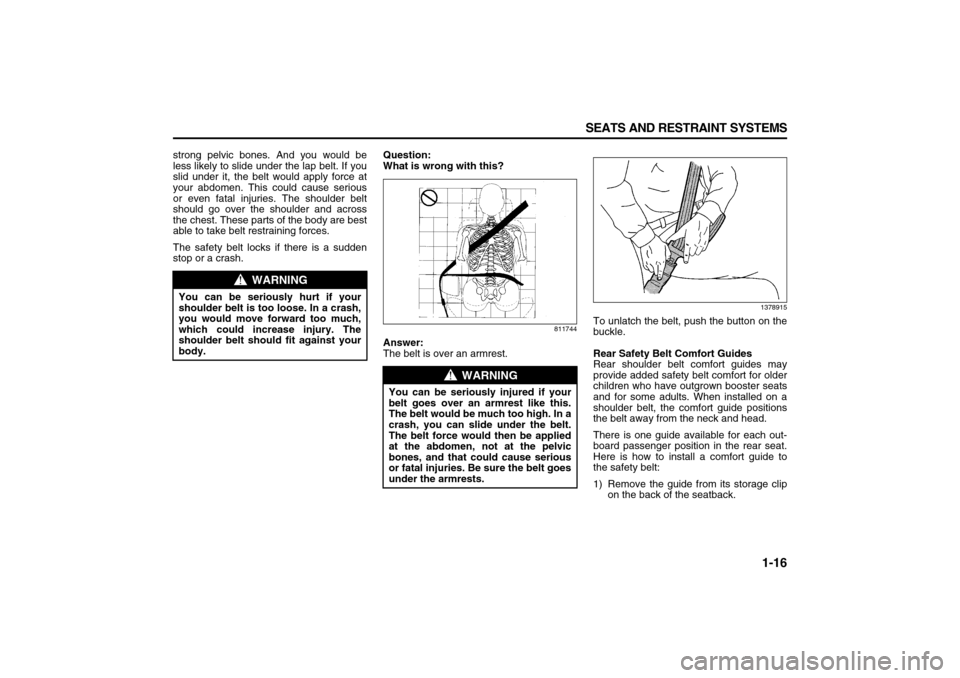
1-16 SEATS AND RESTRAINT SYSTEMS
78J00-03E
strong pelvic bones. And you would be
less likely to slide under the lap belt. If you
slid under it, the belt would apply force at
your abdomen. This could cause serious
or even fatal injuries. The shoulder belt
should go over the shoulder and across
the chest. These parts of the body are best
able to take belt restraining forces.
The safety belt locks if there is a sudden
stop or a crash.Question:
What is wrong with this?
811744
Answer:
The belt is over an armrest.
1378915
To unlatch the belt, push the button on the
buckle.
Rear Safety Belt Comfort Guides
Rear shoulder belt comfort guides may
provide added safety belt comfort for older
children who have outgrown booster seats
and for some adults. When installed on a
shoulder belt, the comfort guide positions
the belt away from the neck and head.
There is one guide available for each out-
board passenger position in the rear seat.
Here is how to install a comfort guide to
the safety belt:
1) Remove the guide from its storage clip
on the back of the seatback.
WARNING
You can be seriously hurt if your
shoulder belt is too loose. In a crash,
you would move forward too much,
which could increase injury. The
shoulder belt should fit against your
body.
WARNING
You can be seriously injured if your
belt goes over an armrest like this.
The belt would be much too high. In a
crash, you can slide under the belt.
The belt force would then be applied
at the abdomen, not at the pelvic
bones, and that could cause serious
or fatal injuries. Be sure the belt goes
under the armrests.
Page 40 of 274

1-28 SEATS AND RESTRAINT SYSTEMS
78J00-03E
to Put the Restraint” in this section for
additional information.Securing a Child Restraint
Designed for the LATCH System
1252139
A. Passenger’s side rear seat lower
anchors
B. Center rear seat lower anchors
C. Driver’s side rear seat lower anchors
Make sure to attach the child restraint at
the proper anchor location.
This system is designed to make installa-
tion of child restraints easier. When using
lower anchors, do not use the vehicle’s
safety belts. Instead use the vehicle’s
anchors and child restraint attachments to
secure the restraints. Some restraints also
use another vehicle anchor to secure a top
tether.
1) Attach and tighten the lower attach-
ments to the lower anchors. If the child
restraint does not have lower attach-
ments or the desired seating position
does not have lower anchors, secure
WARNING
If a LATCH-type child restraint is not
attached to anchors, the restraint will
not be able to protect the child cor-
rectly. In a crash, the child could be
seriously injured or killed. Make sure
that a LATCH-type child restraint is
properly installed using the anchors,
or use the vehicle’s safety belts to
secure the restraint, following the
instructions that came with that
restraint, and also the instructions in
this manual.
WARNING
Each top tether anchor and lower
anchor in the vehicle is designed to
hold only one child restraint. Attach-
ing more than one child restraint to a
single anchor could cause the anchor
or attachment to come loose or even
break during a crash. A child or oth-
ers could be injured if this happens.
To help prevent injury to people and
damage to your vehicle, attach only
one child restraint per anchor.
WARNING
Children can be seriously injured or
strangled if a shoulder belt is
wrapped around their neck and the
safety belt continues to tighten.
Secure any unused safety belts
behind the child restraint so children
cannot reach them. Pull the shoulder
belt all the way out of the retractor to
set the lock, if your vehicle has one,
after the child restraint has been
installed. Be sure to follow the
instructions of the child restraint
manufacturer.
CAUTION
Contact between the child restraint or
the LATCH attachment parts and the
vehicle’s safety belt assembly may
cause damage to these parts. Make
sure when securing unused safety
belts behind the child restraint that
there is no contact between the child
restraint or the LATCH attachment
parts and the vehicle’s safety belt
assembly.
Folding an empty rear seat with the
safety belts secured may cause dam-
age to the safety belt or the seat.
When removing the child restraint,
always remember to return the safety
belts to their normal, stowed position
before folding the rear seat.
Page 42 of 274
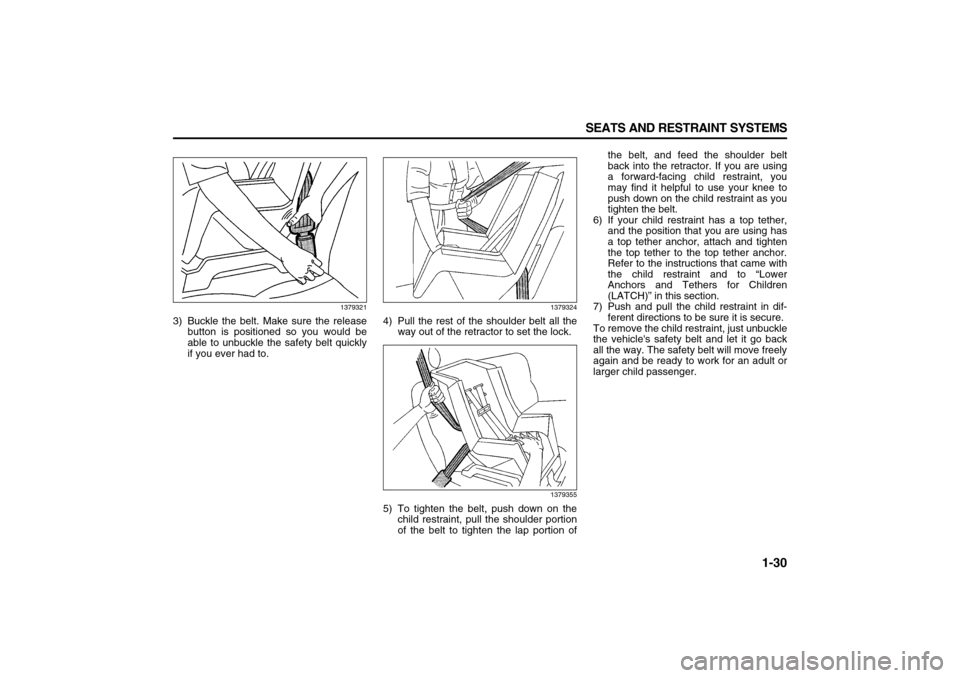
1-30 SEATS AND RESTRAINT SYSTEMS
78J00-03E
1379321
3) Buckle the belt. Make sure the release
button is positioned so you would be
able to unbuckle the safety belt quickly
if you ever had to.
1379324
4) Pull the rest of the shoulder belt all the
way out of the retractor to set the lock.
1379355
5) To tighten the belt, push down on the
child restraint, pull the shoulder portion
of the belt to tighten the lap portion ofthe belt, and feed the shoulder belt
back into the retractor. If you are using
a forward-facing child restraint, you
may find it helpful to use your knee to
push down on the child restraint as you
tighten the belt.
6) If your child restraint has a top tether,
and the position that you are using has
a top tether anchor, attach and tighten
the top tether to the top tether anchor.
Refer to the instructions that came with
the child restraint and to “Lower
Anchors and Tethers for Children
(LATCH)” in this section.
7) Push and pull the child restraint in dif-
ferent directions to be sure it is secure.
To remove the child restraint, just unbuckle
the vehicle's safety belt and let it go back
all the way. The safety belt will move freely
again and be ready to work for an adult or
larger child passenger.
Page 44 of 274
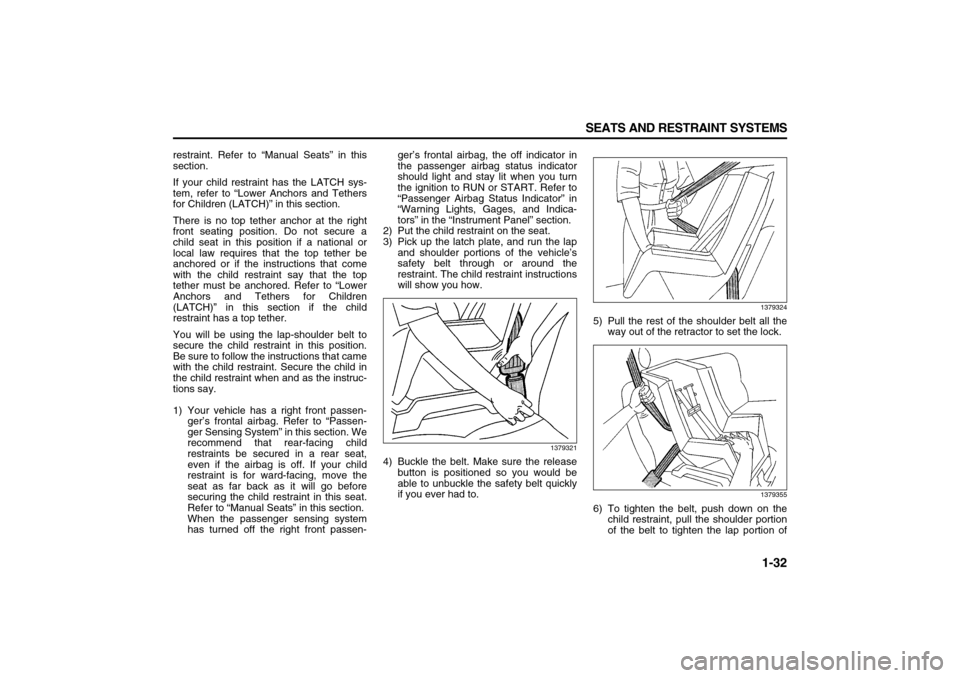
1-32 SEATS AND RESTRAINT SYSTEMS
78J00-03E
restraint. Refer to “Manual Seats” in this
section.
If your child restraint has the LATCH sys-
tem, refer to “Lower Anchors and Tethers
for Children (LATCH)” in this section.
There is no top tether anchor at the right
front seating position. Do not secure a
child seat in this position if a national or
local law requires that the top tether be
anchored or if the instructions that come
with the child restraint say that the top
tether must be anchored. Refer to “Lower
Anchors and Tethers for Children
(LATCH)” in this section if the child
restraint has a top tether.
You will be using the lap-shoulder belt to
secure the child restraint in this position.
Be sure to follow the instructions that came
with the child restraint. Secure the child in
the child restraint when and as the instruc-
tions say.
1) Your vehicle has a right front passen-
ger’s frontal airbag. Refer to “Passen-
ger Sensing System” in this section. We
recommend that rear-facing child
restraints be secured in a rear seat,
even if the airbag is off. If your child
restraint is for ward-facing, move the
seat as far back as it will go before
securing the child restraint in this seat.
Refer to “Manual Seats” in this section.
When the passenger sensing system
has turned off the right front passen-ger’s frontal airbag, the off indicator in
the passenger airbag status indicator
should light and stay lit when you turn
the ignition to RUN or START. Refer to
“Passenger Airbag Status Indicator” in
“Warning Lights, Gages, and Indica-
tors” in the “Instrument Panel” section.
2) Put the child restraint on the seat.
3) Pick up the latch plate, and run the lap
and shoulder portions of the vehicle’s
safety belt through or around the
restraint. The child restraint instructions
will show you how.
1379321
4) Buckle the belt. Make sure the release
button is positioned so you would be
able to unbuckle the safety belt quickly
if you ever had to.
1379324
5) Pull the rest of the shoulder belt all the
way out of the retractor to set the lock.
1379355
6) To tighten the belt, push down on the
child restraint, pull the shoulder portion
of the belt to tighten the lap portion of
Page 45 of 274

1-33 SEATS AND RESTRAINT SYSTEMS
78J00-03E
the belt, and feed the shoulder belt
back into the retractor. If you are using
a forward-facing child restraint, you
may find it helpful to use your knee to
push down on the child restraint as you
tighten the belt. You should not be able
to pull more of the belt from the retrac-
tor once the lock has been set.
7) Push and pull the child restraint in dif-
ferent directions to be sure it is secure.
8) If the airbag is off, the off indicator on
the instrument panel will be lit and stay
lit when the key is turned to RUN or
START.
If a child restraint has been installed and
the on indicator is lit, turn the vehicle off.
Remove the child restraint from the vehicle
and reinstall the child restraint.
If, after reinstalling the child restraint and
restarting the vehicle, the on indicator is
still lit, check to make sure that the vehi-
cle’s seatback is not pressing the child
restraint into the seat cushion. If this hap-
pens, slightly recline the vehicle’s seatback
and adjust the seat cushion if possible.
Also make sure the child restraint is not
trapped under the vehicle head restraint. If
this happens, adjust the head restraint.
If the on indicator is still lit, secure the child
in the child restraint in a rear seat position
in the vehicle if one is available and check
with your dealer.To remove the child restraint, if the top
tether is attached to the top tether anchor,
disconnect it. Unbuckle the vehicle’s safety
belt and let it go back all the way. The
safety belt will move freely again and be
ready to work for an adult or larger child
passenger.
Airbag SystemYour vehicle has a frontal airbag for the
driver and a frontal airbag for the right front
passenger. Your vehicle also has roof-
mounted rollover airbags designed for
either side impact or rollover deployment.
Roof-mounted rollover airbags are avail-
able for the driver and the passenger
seated directly behind the driver and for
the right front passenger and the passen-
ger seated directly behind that passenger.
For roof-mounted rollover airbags, the
word AIRBAG will appear along the head-
liner or trim.
Also, if your vehicle has a third row pas-
senger seat, your vehicle will have third
row roof-mounted rollover airbags.
Airbags are designed to supplement the
protection provided by safety belts. Even
though today’s airbags are also designed
to help reduce the risk of injury from the
force of an inflating bag, all airbags must
inflate very quickly to do their job.
Here are the most important things to
know about the airbag system:
Page 57 of 274
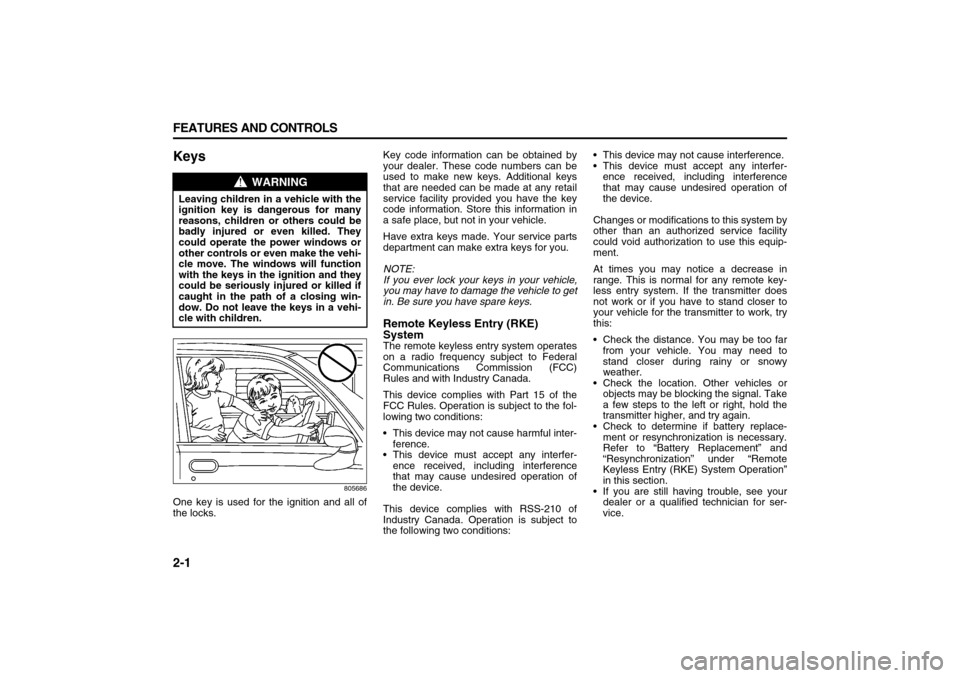
2-1 FEATURES AND CONTROLS
78J00-03E
Keys
805686
One key is used for the ignition and all of
the locks.Key code information can be obtained by
your dealer. These code numbers can be
used to make new keys. Additional keys
that are needed can be made at any retail
service facility provided you have the key
code information. Store this information in
a safe place, but not in your vehicle.
Have extra keys made. Your service parts
department can make extra keys for you.
NOTE:
If you ever lock your keys in your vehicle,
you may have to damage the vehicle to get
in. Be sure you have spare keys.
Remote Keyless Entry (RKE)
SystemThe remote keyless entry system operates
on a radio frequency subject to Federal
Communications Commission (FCC)
Rules and with Industry Canada.
This device complies with Part 15 of the
FCC Rules. Operation is subject to the fol-
lowing two conditions:
This device may not cause harmful inter-
ference.
This device must accept any interfer-
ence received, including interference
that may cause undesired operation of
the device.
This device complies with RSS-210 of
Industry Canada. Operation is subject to
the following two conditions: This device may not cause interference.
This device must accept any interfer-
ence received, including interference
that may cause undesired operation of
the device.
Changes or modifications to this system by
other than an authorized service facility
could void authorization to use this equip-
ment.
At times you may notice a decrease in
range. This is normal for any remote key-
less entry system. If the transmitter does
not work or if you have to stand closer to
your vehicle for the transmitter to work, try
this:
Check the distance. You may be too far
from your vehicle. You may need to
stand closer during rainy or snowy
weather.
Check the location. Other vehicles or
objects may be blocking the signal. Take
a few steps to the left or right, hold the
transmitter higher, and try again.
Check to determine if battery replace-
ment or resynchronization is necessary.
Refer to “Battery Replacement” and
“Resynchronization” under “Remote
Keyless Entry (RKE) System Operation”
in this section.
If you are still having trouble, see your
dealer or a qualified technician for ser-
vice.
WARNING
Leaving children in a vehicle with the
ignition key is dangerous for many
reasons, children or others could be
badly injured or even killed. They
could operate the power windows or
other controls or even make the vehi-
cle move. The windows will function
with the keys in the ignition and they
could be seriously injured or killed if
caught in the path of a closing win-
dow. Do not leave the keys in a vehi-
cle with children.
Page 61 of 274
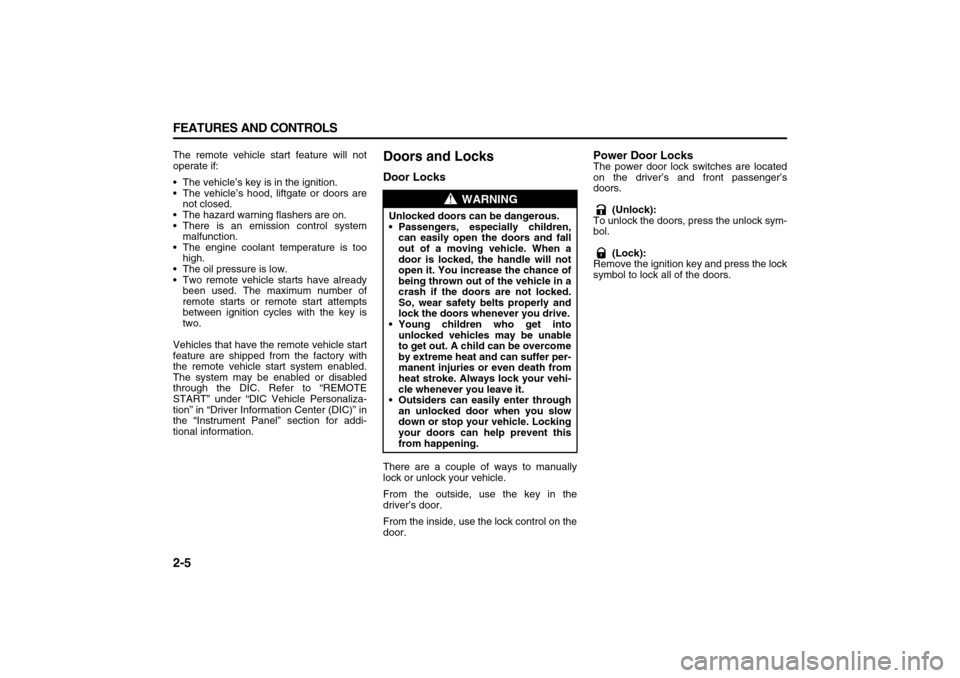
2-5 FEATURES AND CONTROLS
78J00-03E
The remote vehicle start feature will not
operate if:
The vehicle’s key is in the ignition.
The vehicle’s hood, liftgate or doors are
not closed.
The hazard warning flashers are on.
There is an emission control system
malfunction.
The engine coolant temperature is too
high.
The oil pressure is low.
Two remote vehicle starts have already
been used. The maximum number of
remote starts or remote start attempts
between ignition cycles with the key is
two.
Vehicles that have the remote vehicle start
feature are shipped from the factory with
the remote vehicle start system enabled.
The system may be enabled or disabled
through the DIC. Refer to “REMOTE
START” under “DIC Vehicle Personaliza-
tion” in “Driver Information Center (DIC)” in
the “Instrument Panel” section for addi-
tional information.
Doors and LocksDoor LocksThere are a couple of ways to manually
lock or unlock your vehicle.
From the outside, use the key in the
driver’s door.
From the inside, use the lock control on the
door.
Power Door LocksThe power door lock switches are located
on the driver’s and front passenger’s
doors.
(Unlock):
To unlock the doors, press the unlock sym-
bol.
(Lock):
Remove the ignition key and press the lock
symbol to lock all of the doors.
WARNING
Unlocked doors can be dangerous.
Passengers, especially children,
can easily open the doors and fall
out of a moving vehicle. When a
door is locked, the handle will not
open it. You increase the chance of
being thrown out of the vehicle in a
crash if the doors are not locked.
So, wear safety belts properly and
lock the doors whenever you drive.
Young children who get into
unlocked vehicles may be unable
to get out. A child can be overcome
by extreme heat and can suffer per-
manent injuries or even death from
heat stroke. Always lock your vehi-
cle whenever you leave it.
Outsiders can easily enter through
an unlocked door when you slow
down or stop your vehicle. Locking
your doors can help prevent this
from happening.